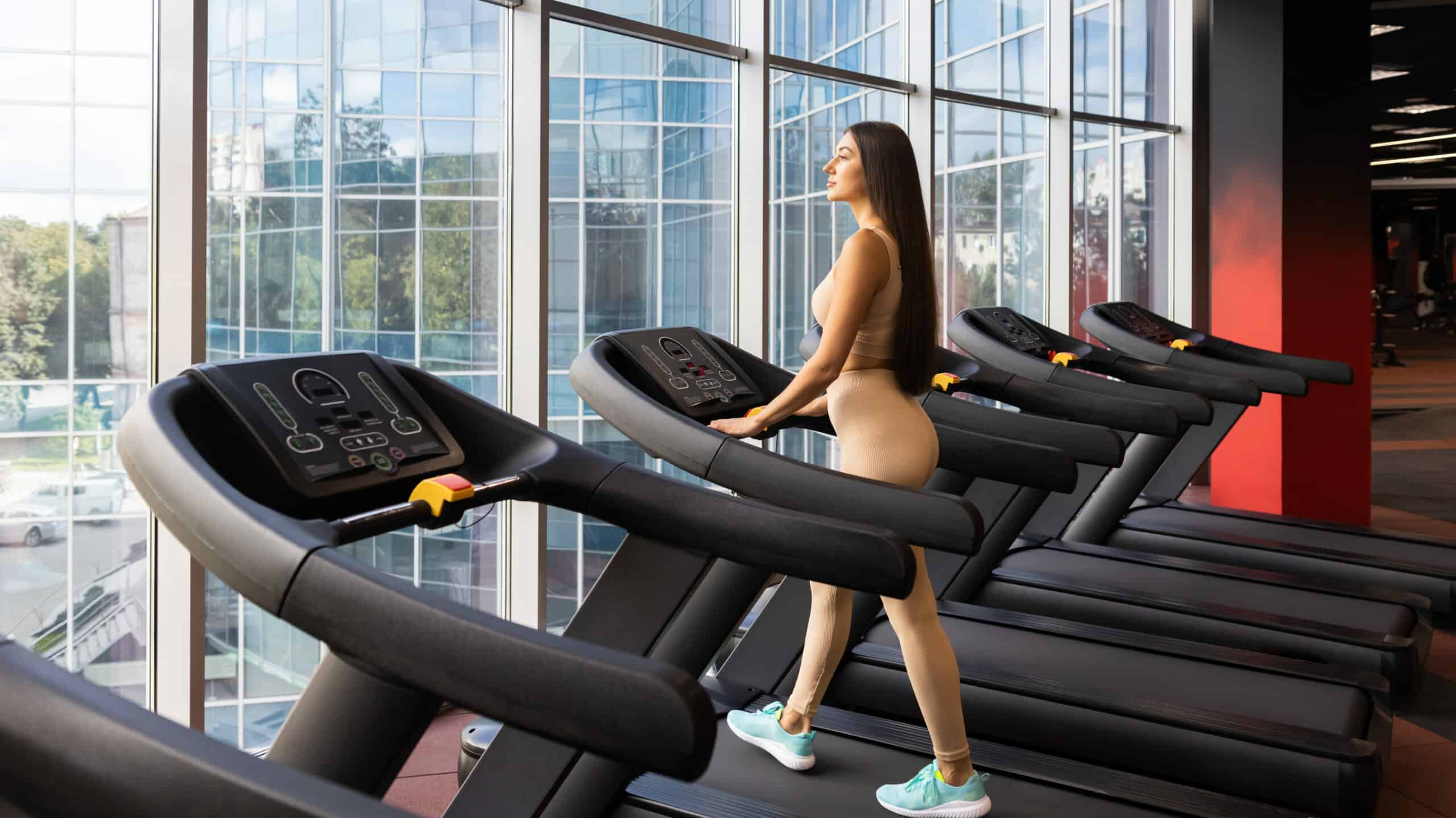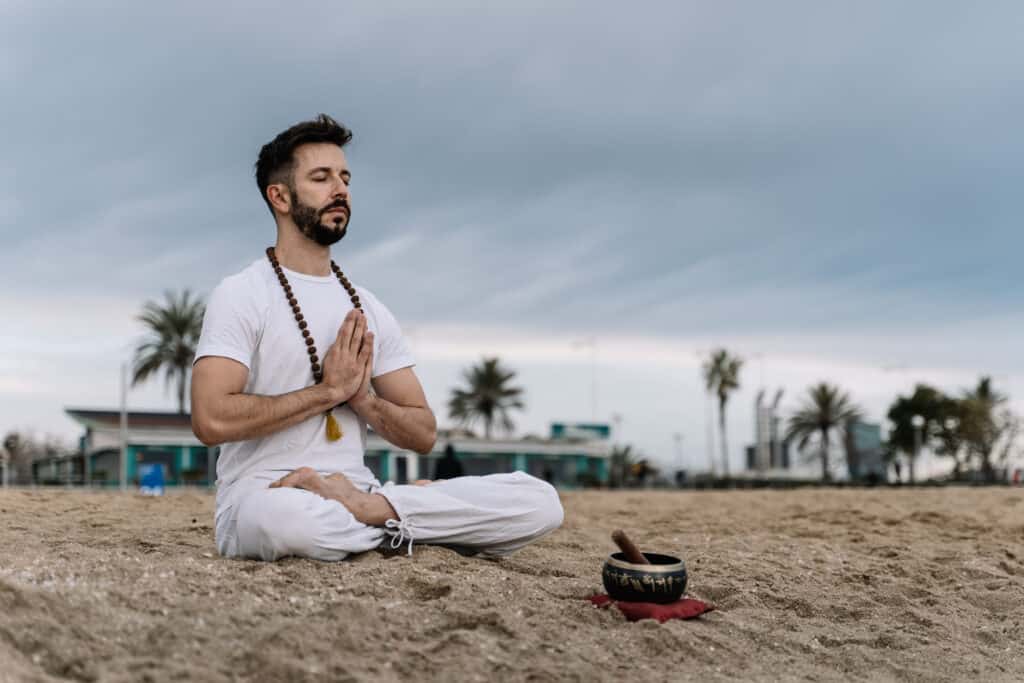Walking meditation benefits are abundant and offer a unique way to practice mindfulness in our daily lives. This practice unites physical motion and psychological attention, supplying a way for people who want to enhance their well-being or pursue spiritual growth to establish an intimate connection with themselves.
In this blog post, we will explore the basics of walking meditation, including understanding mindfulness meditation and incorporating mindful walking into your daily routine. We’ll also discuss finding an ideal location for your practice, focusing on body movements during walking meditation, observing thoughts, feelings, and moods while practicing mindful walking, and cultivating relaxation and open-heartedness through mindful steps.
Furthermore, we delve into the numerous advantages that come from engaging in this type of seated meditation practice such as mental health benefits and physical improvements. Lastly, you’ll discover tips and tricks for successful walking meditation practice like overcoming distractions and maintaining consistency. By integrating these techniques into your life, you can experience the transformative power of walking mediation benefits firsthand.
The Basics of Walking Meditation

Walking meditation is a form of mindfulness practice that can be done while engaging in various activities, such as sitting at a desk or doing the dishes. This unique approach to meditation offers an alternative for those who find traditional seated meditation practices challenging or monotonous. In this section, we will explore walking meditation and its benefits for both beginners and advanced practitioners.
Understanding Mindfulness Meditation
Attending to the here and now without judgment is what mindfulness meditation involves, a practice that can be utilized by both novices and experienced meditators. By practicing mindfulness, one can gain greater insight into the self and become better equipped to handle stressful situations. Mindful.org provides an excellent introduction to mindfulness and its numerous benefits.
In walking meditation, also known as mindful walking, you apply these principles of mindfulness while moving through space rather than remaining stationary in a seated position. As you walk slowly and deliberately, pay close attention to your physical sensations – such as the feeling of your feet touching the ground – along with any thoughts or emotions that arise during your practice.
Incorporating Walking into Your Daily Routine
- Create opportunities: Look for moments throughout your day when you can incorporate mindful walking into everyday tasks like commuting to work or taking breaks between meetings.
- Schedule dedicated time: If possible, set aside specific times each day for focused walking meditation sessions lasting anywhere from 10 minutes up to an hour depending on personal preference.
- Vary locations: Experiment with different environments – indoors vs outdoors – so long as they provide minimal distractions allowing full concentration on bodily movements & mental states experienced during walks.
By incorporating walking meditation into your daily routine, you can experience the physical and mental benefits of mindfulness practice while also enjoying a refreshing change from traditional seated meditation practices.
The basics of walking meditation can help bring clarity and focus to your life, allowing you to experience greater well-being. With the right location, incorporating this practice into your daily routine is easy; let’s explore how to find an ideal spot for walking meditation.
Finding an Ideal Location for Walking Meditation
Choosing the right location is crucial to fully experience the benefits of walking meditation. A suitable environment will allow you to focus on your practice without distractions, enabling you to engage in mindful walking more effectively. In this part, we’ll investigate a variety of indoor and outdoor locales to help create an ambiance suitable for walking meditation.
Indoor vs Outdoor Settings
Both indoor and outdoor environments can be ideal locations for practicing walking meditation. The choice largely depends on personal preference, weather conditions, and available space. Indoor spaces offer a controlled environment with minimal external distractions such as noise or uneven terrain. Some examples of indoor locations include:
- A quiet room in your home
- An empty hallway at work during breaks
- A dedicated meditation space within a spiritual center or yoga studio
Outdoor settings often provide fresh air, natural scenery, and sunlight that can enhance the overall experience of mindful walking. Popular choices for outdoor locations are:
- Parks or gardens with well-maintained paths free from obstacles
- Nature trails offering serene surroundings away from urban chaos
Choosing the right location for walking meditation is essential to reap its full benefits. To focus on your body movements during this practice, it is important to pay attention to each step and maintain an upright alignment.
Focusing on Your Body Movements During Walking Meditation

In this section, we’ll discuss how focusing on the movement of your feet and legs during walking meditation helps create awareness about your body’s sensations. We’ll also cover techniques to maintain proper posture while practicing this form of mindfulness exercise.
Paying Attention to Each Step
One of the key aspects of walking meditation is paying close attention to each step you take. This practice encourages mindfulness of your physical feelings and helps you to remain focused on the present. To do this effectively, follow these steps:
- Begin by standing still and taking a few deep breaths, allowing yourself to become centered and grounded.
- As you start walking slowly, focus on lifting one foot off the ground and then placing it down gently with intention.
- Notice how your weight shifts from one leg to another as you walk, feeling every muscle involved in each step.
- If your mind starts wandering or becomes distracted by external stimuli, gently bring it back to focus on each individual step.
Maintaining Upright Alignment
A crucial aspect of mindful walking is maintaining an upright alignment throughout the practice. This not only promotes better posture but also enhances overall wellbeing by reducing symptoms associated with poor posture such as neck pain or lower back issues. Follow these tips for maintaining proper alignment during seated meditation practice:
- Head position: Keep your head balanced above your shoulders without tilting forward or backward too much; imagine a string pulling up from the crown towards the sky for guidance.
- Shoulders: Allow your shoulders to relax and drop down, avoiding any tension or hunching.
- Chest: Keep your chest open and lifted, allowing for natural breathing without constriction.
- Pelvis: Ensure that your pelvis is neutral and not tilted too far forward or backward. This helps maintain the natural curve of your lower back.
Incorporating these techniques into your walking meditation practice will help you develop a greater awareness of physical sensations while also promoting proper posture. As you continue practicing mindful walking, you’ll find it easier to maintain an upright alignment even during everyday activities outside of seated meditation practice – ultimately leading to improved overall well-being.
Exploring your bodily motions when engaged in walking meditation can help you build an enhanced cognizance of yourself and the atmosphere around you. Transitioning to observing thoughts, feelings & moods while practicing mindful walking is an important step in deepening your practice and cultivating emotional intelligence.
Observing Thoughts, Feelings & Moods While Practicing Mindful Walking

In this section, we’ll discuss how paying attention not only involves observing physical movements but also noticing thoughts, feelings & moods that arise throughout the process. Discover ways to cultivate non-judgmental awareness towards these mental states during your practice.
Developing Emotional Intelligence through Observation
A key aspect of mindfulness meditation, including walking meditation, is developing emotional intelligence by becoming more aware of our thoughts and emotions as they occur. By practicing mindful walking regularly, you can train yourself to observe your internal experiences without getting caught up in them or reacting impulsively.
- Recognize: As you walk mindfully, take note of any thoughts or emotions that come up. Acknowledge their presence without judgment.
- Accept: Instead of trying to suppress or change these feelings and thoughts, accept them as natural occurrences within the mind.
- Inquire: Investigate what may have triggered these emotions or thought patterns – be curious about their origins and effects on your well-being.
- Note: Make a mental note when certain patterns emerge repeatedly during your walks so you can further explore them later in seated meditation practice or with a life coach if needed.
Techniques for Managing Intrusive Thoughts
Mindful walking helps us become more aware of our thought processes; however, it’s common for intrusive thoughts to appear while engaging in this practice. Here are some techniques for managing such distractions effectively:
- Labeling: When an intrusive thought arises, label it as “thinking” or categorize it based on its content (e.g., “worry,” “planning”). This helps create some distance between you and the thought.
- Gently redirect: After labeling the thought, gently bring your focus back to the physical sensations of walking – feel each step and observe how your body moves.
- Maintain perspective: Remind yourself that thoughts are just mental events and not necessarily reflections of reality. By maintaining this perspective, you can prevent getting caught up in them during your practice.
Engaging these approaches in your ambulatory reflection habit will assist you in growing a more profound understanding of yourself while abating indications of tension and uneasiness. Remember that progress takes time; be patient with yourself as you continue to cultivate mindfulness through mindful walking practices.
By observing our thoughts, feelings, and moods while practicing mindful walking, we can develop emotional intelligence that allows us to manage intrusive thoughts. Cultivating relaxation and open-heartedness through mindful steps is the next step in deepening our practice of mindfulness meditation for improved well-being.
Cultivating Relaxation & Open-heartedness Through Mindful Steps
Learn how adopting a relaxed yet open-hearted approach during mindful walks contributes significantly towards enhancing overall well-being. Explore methods aimed at fostering relaxation within yourself as you take each step mindfully – ultimately leading to a more balanced and harmonious state of mind.
Techniques for Achieving Relaxation During Walking Meditation
To experience the full benefits of walking meditation, it’s essential to cultivate a sense of relaxation while practicing. Here are some techniques that can help you achieve this:
- Breathing awareness: Focus on your breath as you walk, inhaling deeply through your nose and exhaling slowly through your mouth. Maintaining a mindful attitude while walking can help you stay in the present and reduce any physical tension or discomfort.
- Maintain proper posture: Ensure that your body is upright, aligned, and dignified throughout the practice. This allows for better circulation and reduces physical tension or discomfort.
- Pace yourself: Walk at a comfortable pace that enables you to maintain mindfulness without feeling rushed or stressed.
- Savor the environment: Take time to appreciate the beauty around you – whether it’s nature or an indoor setting – by engaging all five senses during walking meditation.
The Importance of an Open-Hearted Attitude
An open-hearted attitude plays a crucial role in achieving mental clarity and emotional balance during walking meditation practices. By cultivating this mindset, practitioners can effectively manage their thoughts and emotions while remaining receptive to new insights gained from their experiences. Some ways to develop an open-hearted attitude include:
- Acknowledge impermanence: Recognize that everything is in a constant state of change, including your thoughts and emotions. This understanding can help you let go of any attachment to specific outcomes or expectations during walking meditation.
- Cultivate compassion: Develop empathy for yourself and others by acknowledging the shared human experience of suffering. This can lead to increased kindness and understanding towards oneself and others during mindfulness practices like walking meditation.
- Embrace non-judgment: Avoid labeling your experiences as “good” or “bad.” Instead, observe them objectively without judgment, allowing yourself to learn from each moment with curiosity and openness.
By implementing these techniques, you can not only enrich your walking meditation experience but also drastically reduce stress and boost mental clarity as well as emotional well-being. To further explore the world of mindfulness practices such as seated meditation practice or life coaching services tailored specifically for spiritual seekers looking to improve their wellbeing, consider visiting Mindworks.
By cultivating a relaxed attitude and an open-hearted approach to walking meditation, we can begin to reap the many physical and mental health benefits of this mindful practice. Advantages such as improved concentration, stress relief, better balance, and coordination are just some of the rewards that come with engaging in regular walking meditations.
Advantages & Benefits of Walking Meditation

For experienced and novice practitioners alike, walking meditation can bring about a range of benefits that can be felt both mentally and physically. From improved mental clarity to enhanced physical health, this section highlights various benefits associated with mindful walking.
Mental Health Benefits
- Reduces stress: Practicing mindfulness through walking meditation has been shown to help in reducing symptoms of stress. By focusing on the present moment and being aware of our thoughts, feelings, and physical sensations, we can better manage our response to stressful situations.
- Improves focus and concentration: As you pay attention to each step during your walk, you train your mind to stay focused on a single task. This skill translates into other areas of life where increased concentration is required.
- Promotes emotional well-being: Observing thoughts without judgment allows us to develop greater self-awareness and emotional intelligence. This leads to an improved ability in managing emotions effectively throughout everyday challenges.
Physical Health Improvements
- Increase in overall fitness levels: Unlike seated meditation practices, walking meditation involves gentle physical activity that helps improve cardiovascular health over time when practiced regularly.
- Better posture: Maintaining upright alignment while practicing mindful walking encourages proper body mechanics which contribute towards healthier posture habits even outside the practice session.
- Balancing energy levels: Mindful walks have been found effective at promoting relaxation while also providing an energy boost. This balance of relaxation and energy is essential for overall well-being.
With these mental and physical benefits, it’s clear that walking meditation can be a valuable addition to your daily routine. By cultivating mindfulness during walks, you’ll not only enhance your meditation practice but also improve various aspects of your life. To learn more about the benefits of mindfulness practices, check out this comprehensive guide on What is Mindfulness.
The advantages and benefits of walking meditation are numerous, from improved mental health to physical health improvements. Guidelines for achieving a successful and regular walking meditation can be put into place to ensure that its rewards are reaped.
Tips & Tricks for Successful Walking Meditation Practice

Embarking on a walking meditation journey can be both rewarding and challenging. To ensure your practice is successful, having some tips and tricks in hand can be beneficial. This section offers practical advice on overcoming common challenges faced by individuals as they embark on their mindful journey – ultimately helping you establish a consistent and effective practice.
Overcoming Distractions
Distractions are inevitable during any form of meditation, including walking meditation. Nevertheless, one can diminish the effect of distractions and stay focused during meditation with a suitable approach. Here are some strategies to help you overcome distractions:
- Acknowledge the distraction: When a distracting thought or sensation arises, acknowledge its presence without judgment before gently returning your attention back to the physical sensations of walking.
- Create an anchor: Use the feeling of each step as an anchor for your awareness. By focusing intently on this sensation, it becomes easier to let go of distractions that may arise.
- Breathing techniques: Incorporate deep breathing exercises into your walking meditation routine; this helps calm the mind while also providing another point of focus alongside physical movements.
Maintaining Consistency in Practice
To reap the full benefits of walking meditation such as reducing stress levels and improving overall well-being it is crucial to develop consistency in practicing mindfulness regularly. The following suggestions will assist you in maintaining commitment towards cultivating a successful seated or walking meditation practice:
- Set a schedule: Establishing a regular routine for your meditation practice can help create consistency. Choose specific times and days that work best for you, and commit to practicing during those periods.
- Vary the location: To keep things fresh and engaging, consider alternating between different locations for your walking meditation sessions such as parks, gardens, or quiet indoor spaces.
- Join a group or find an accountability partner: Practicing with others who share similar goals can provide motivation and support in maintaining consistent mindfulness practices. Look into local meditation groups or enlist the help of a friend to hold each other accountable.
Incorporating these tips into your daily life will not only enhance the effectiveness of your walking meditation but also contribute significantly towards achieving greater mental clarity, reduced stress levels, and improved overall well-being. Remember that patience is key; progress may be gradual but ultimately rewarding when consistently practiced over time.
Frequently Asked Questions Walking Meditation Benefits
Is walking a good form of meditation?
Yes, walking is an excellent form of meditation. It combines physical activity with mindfulness, helping to cultivate awareness and relaxation while improving overall well-being. Walking meditation can be practiced by anyone, regardless of fitness level or experience in traditional sitting meditation practices.
Is walking meditation as effective as sitting meditation?
Walking meditation can be just as effective as sitting meditation when practiced correctly. Both forms offer unique benefits; while sitting focuses on stillness and concentration, walking encourages mindful movement and a deeper connection with the body. Choosing between the two depends on personal preference and individual needs.
How does walking meditation work?
Walking meditation works by focusing attention on each step taken during a walk. Practitioners maintain an upright posture, paying close attention to their breath and bodily sensations throughout the process. This practice helps develop mindfulness skills that promote mental clarity, emotional balance, and enhanced self-awareness.
How can walking meditation improve your mental health?
Walking meditation offers numerous mental health benefits such as reduced stress levels, improved mood regulation, increased focus & concentration abilities along with better emotional resilience source. Regular practice fosters greater self-awareness which contributes positively towards one’s overall psychological well-being.
Conclusion
In conclusion, walking meditation is a potent practice that can offer numerous advantages for both the mental and physical realms. By incorporating mindfulness into our daily walks, we can cultivate relaxation, emotional intelligence, and open-heartedness while reducing stress and improving physical health.








